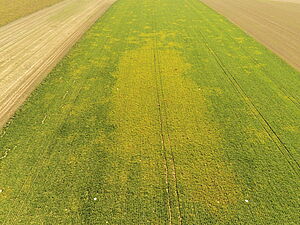

Accueil / French National Plan for research and innovation (consolidated)

The National Plan for Research and Innovation (consolidated) aims to carry on research for solutions to control aphids and sugar beet yellows by the end of 2026.
Suscribe to PNRI newsletter (monthly) : PNRInfo
During 2020, French sugarbeet farmers faced a terrible infestation of Beet Yellow Virus (BYV). About 30% of their performances were impacted.

The population of green peach aphids (Mysus Persicae), main vector of the BYV was controlled from 1993 until 2018 thanks to the use of neonicotinoid (NNI), efficient pesticides that coat the seeds. Farmers tried other kind of pesticides that were not efficient enough to avoid the disease damages. Despite the attempts of research (several projects were launched such as AKER, ABCD-B, EXTRAPOL, MoCoRiBa…), neither chemical nor natural solutions that could compete with the NNI’s efficiency have been identified.
Today the sector is facing an emergency situation with a high risk of decline. That’s why, the French government has undertaken a major plan: “The National Plan for Research and Innovation : towards operational solutions against Beet Yellow Virus”.
At the end of 2023, the government decided to extend the research plan with a (consolidated) PNRI-C for three more years (2024-2026), with the aims of:
PNRI-C aims at empowering the research and innovation through 4 Axes :
 1/ Improve the understanding of the sanitary situation
1/ Improve the understanding of the sanitary situation
This axe’s objective is to understand the processes involved between aphids and the virus, to monitor in real time, anticipate, and control the population of aphid during the following years. Another objective is to develop new control strategies against BYV. Working on the favourable conditions of the disease’s development will help researchers to identify the virus’s reserves, identify the complete viral register of BYV and develop new virus detection tools to improve epidemiological monitoring and facilitate future research work.
 2/ Identification and demonstration of solutions on a crop scale
2/ Identification and demonstration of solutions on a crop scale
This axe aims to resume the trials undertaken in collaboration with phytosanitary companies to identify possible new treatments (especially biocontrol products) and to improve the understanding of plant behaviour (genetic capacity of varieties to resist or tolerate the presence of different viruses and the effects of changes within crops).
Crop protection, biocides, and biocontrol:
- Resume experimentations and identify what worked and what did not in 2019 and 2020.
- Extend tests to other crops permissible, to consider extensions
- Experiment defence stimulators to limit the development of the viral infection and thus reduce the spread of the virus
- Exploring molecules’ composition to inhibit plant colonisation by aphids (with the aim of blocking virus acquisition and/or inoculation).
Plant behaviour in cultivation:
- Identify new sources of resistance
- Explore the varieties reactions concerning the viruses and establish protection modalities such as vaccination
- Identify specific responses of beet to aphids, reducing the aphid's appetence for beet varieties
- Identify the impact of cultural practices on the aphid
 3/ Identification and demonstration of regulatory solutions at the scale of plant environment, crop, and landscapes
3/ Identification and demonstration of regulatory solutions at the scale of plant environment, crop, and landscapes
This axe consists of integrating agro ecological reflections into the studies. This involves examining the factors limiting the aphid’s arrival and controlling the regulations:
- Identifying and testing vegetal species with a repellent effect against Aphids in order to reduce the attractiveness of beet to green aphids (VOCs - Volatile Organic Compounds)
- Increase the ability of regulation alongside the crops (plants hosting a high population of beneficial insects or release beneficial insects directly on fields, finding out how to implement them in a sustainable way…)
- Determine the potential of burying covers of grasses with endophytes (Neotyphodium uncinatum) before sowing, which would allow the production of 2 alcaloïdes : Loline and Peramine
- Design scenarios of landscape management about the aphid-beet-auxiliary pathosystem.
 4/ Transition toward a sustainable economic model
4/ Transition toward a sustainable economic model
The last axis of the PNRI is transversal. It aims to evaluate the economic impact of the technical evolutions resulting from the explored paths. The aim is to define the conditions of acceptability and performance of a solution, or a set of solutions, not only considering its technical efficiency but also its economic efficiency, particularly in terms of employment. The objective is to evaluate the sustainability of the models studied: taking into account the economic condition of farmers, insurance approaches and the support modality of the future CAP.
INRAE has a scientific responsibility for the PNRI-C while ITB has a functional management responsibility.
The governance of the PNRI-C is ensured by:
The PNRI was an unprecedented research effort. This plan was subsidized by public funding up to 7 million euros over 3 years. The total amount of this plan reached more than 20 million euros with a co-financing from INRAE, ITB and seed companies. It represented around twenty projects, thirty public and private stakeholders, and about 200 researchers, engineers and technicians involved within the program.
PNRI-C succeeds PNRI, with a budget of 4 million euros over 3 years. Funding is both public (government) and private (ITB, INRAE, project partners). A total of 5 projects have been selected to carry out further research into controlling sugar beet yellows, involving around fifteen partners.
